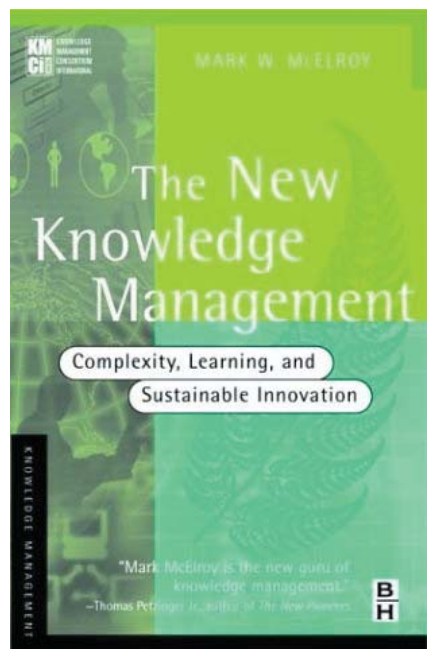A review of The New Knowledge Management: Complexity, Learning and Sustainable Innovation
Written by Mark McElroy, published by Butterworth-Heinemann ISBN 0750676086 (2002)
Bill Godfrey

Introduction
This book Key Issues in the New Knowledge Management (Firestone & McElory, ISBN 0750676558, 2003) have so much in common that they are reviewed together. Both pursue essentially the same theme. One is mainly a republication of a collection of articles, while the other explores issues arising from the concepts and structures discussed in the first. There is a good deal of repetition within and between the books.
There is good material in both, including some useful diagrams, but both are written in a dreadfully convoluted and jargon-ridden style. The style was once very popular in academic writing and was brilliantly parodied in an excruciatingly funny article called “Salt Passage,” which pretended to be a study of the link between the use of the words “pass the salt” and the passage of the salt pot along a communal table. I had hoped that the style had died - but evidently not.
The central argument is based on the following propositions:
- Knowledge management is concerned with both knowledge production (developing new knowledge, or learning), and with holding, organizing, storing and distributing existing knowledge;
- These processes occur within (and between) organizations and the individuals within them, which are best seen as complex adaptive systems, and are self-organizing;
- Knowledge management is best seen as the metaprocess which helps management to foster this set of systemically linked processes and to link it to the aims and strategies of the organization;
- McElroy argues that the processes associated with knowledge development (which he calls ‘second-generation knowledge management’) are relatively neglected, but are essential to a healthy ‘knowledge management life cycle’;
- Firestone and McElroy then go into a good deal of detail about the issues involved in fostering and applying the knowledge management life cycle and ensuring that the fit between the human and the technology aspects of knowledge management is good.
Curiously, neither book addresses the central question that concerns most commercial managers, which is: How do I ensure that I develop or acquire commercially valuable knowledge and that that knowledge does get to and get used by the people I want it to (e.g., staff) and does not get to people I do not want it to (e.g., competitors), such that I can maximize the value derived and retained from that knowledge? (Note that this includes consideration of the commercial and other advantages of decisions on open source knowledge and that rather different considerations apply in the public sector.)
For a better exploration of the answer to that crucial question, the manager should go to Max Boisot’s Knowledge Assets: Securing Competitive Advantage in the Information Economy (ISBN 019829607X, 1999). Both the books in this review fail to explore how organizations or their management identify the particular bodies of knowledge that are most valuable to them.
Put in the bald terms of the above dot points, the authors do not seem to be offering anything particularly new, and too much of their space is in fact devoted to knocking down the ‘straw man’ proposition that current knowledge management focuses only (or excessively) on the processes involved in holding, organizing storing and distributing existing knowledge.
Knowledge management as we know it today has in fact emerged from the alliance, sometimes reluctantly and sometimes enthusiastically, between at least three distinct groups of specialists:
- IT professionals, concerned primarily with the capture, organization, storage, manipulation and distribution of data and information;
- Organization development and related professionals, concerned primarily with individual and organizational learning and the transfer of useful knowledge and skills between individuals and groups; and
- Specialists in innovation of products, processes and services, who in a sense work back from these outputs and outcomes to the human skills, information and infrastructure needed to support them.
(At the same time, the recognition of knowledge as a critically important factor of production has given rise to a related discipline of identifying, measuring and accounting for the value of these intangible assets - see for example, Karl Sveiby’s The New Organizational Wealth, ISBN 1576750140, 1997)
Much of the text of these two books is in effect seeking to ‘rebadge’ the established perspectives, disciplines and ways of thinking of these diverse groups as subsets of the central new discipline of Knowledge Management (capital K, capital M). McElroy goes so far as to propose that it should be the oversight discipline over all others reporting to the Board. This contrasts with the more modest ambition of other writers that, as knowledge management becomes better established, it should become understood as part of every leadership and manage-ment role, with a separate Knowledge Management role possibly eventually ‘withering away’.
The literature of knowledge management is now quite rich, with very useful contributions from writers from each of the three streams noted above as well as from specialists in KM. A very high proportion of the references in these two books are to the two authors’ own work, with relatively little reference to the wider literature, although Verna Allee, Tom Davenport and J. S. Brown are also mentioned.